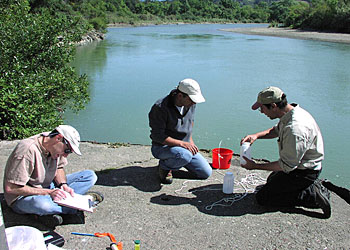HOME > OUR WORK > • River Patrol • Creekkeeper Volunteers
• Water Monitoring • Advocacy • Riverkeeper Park • Foss Creek Project • Education

Water Monitoring
WHY MONITORING IS NECESSARY
Water quality monitoring builds stewardship by engaging and educating citizen volunteers and allows for better public policy decisions by increasing water quality data.
Water quality monitoring builds stewardship by taking interested volunteers and teaching them about watershed dynamics and water quality during the training process. At the end of our training sessions volunteers have increased their knowledge about what pollutants are present, why they are a problem and can share that information with others.
Gathering water quality data is vital due to budget constraints on regulatory agencies that create data gaps and in order to make sound public policy decisions. Data gaps sometimes delay identification of problems or understate their severity. Lack of sufficient water quality data makes for uninformed public policy decisions as well.
Russian Riverkeeper manages and assists with a variety of water quality monitoring projects to improve watershed understanding and add valuable information to public policy decisions. Most of our work is performed with trained volunteer water quality monitors. Training volunteer monitors is a cost effective way to gather defensible water quality data and increases stewardship of our river. Our major projects are listed below, we encourage your participation - Get on the River and help us find out what's in the River!
CURRENT WATER MONITORING PROJECTS
Russian River First FlushIn the Russian River watershed our Coastal California semi-arid climate gives us long dry summers and rain only during the winter months allowing pollutants to accumulate on land where they are washed into creeks with the first rain of winter. This first rain event is often referred to as "First Flush", when research has shown stormwater runoff can represent "the worst case scenario" in terms of stormwater pollution. Gathering first flush water quality data throughout a watershed gives municipal officials, regulatory agencies and citizens pertinent information on how the sum of all our activities impacts our waterways. Russian River First Flush was created in 2002 by interested and motivated citizen volunteers working with Dr Revital Katznelson, Regional Citizen Monitoring Coordinator of the Clean Water Team (the Citizen Monitoring Program of the State Water Resources Control Board) and supported by other agencies sharing a curiosity about the "worst-case scenario" in this watershed. Each year First Flush attracts dozens of new volunteers primarily because citizens are growing more concerned about local water quality.
The Russian River First Flush monitoring was intended to characterize the runoff in different parts of the watershed and identify sources of potential pollutants (Please note that stormwater 'constituents' such as ammonia, metals, or sediments are not considered 'pollutants' if it has not been shown that they cause a problem, as in "innocent until proven guilty"). The information gleaned from this characterization effort can help citizens, local agencies, and regulators prioritize future management options.
To volunteer for Russian River First Flush, click here. [Link to 2002 First Flush report]
Mercury Fish Tissue StudyIn 2004 and 2005, Russian Riverkeeper participated in a national study with the Waterkeeper Alliance to measure Mercury concentrations in Russian River fish. We caught five smallmouth bass from the mainstem river near the Wohler Bridge area and all five exceeded EPA fish consumption advisory levels of 0.30ppm Mercury. The three largemouth bass from Lake Benoist and Lake Wilson at the new Riverfront Park (former gravel pits) were all double or triple the EPA limit. One Steelhead Trout that was reared and returned to the hatchery at Lake Sonoma had a concentration of 0.056 ppm six times less than the EPA limit.
Numerous historic and some ongoing Mercury sources occur in the Russian River watershed. The factors that convert inorganic Mercury to organic or bio-available Mercury are all present in the watershed. Based on our findings and research we obtained a grant from As You Sow Foundation to conduct a follow-up study in Summer of 2006 and work on getting a fish consumption advisory on the Russian River.
[Link to GSA Mercury Abstract]
Text links: • About Us • Our Work • Join Us • Resources • Newsroom • Contact
Copyright 2006 Russian Riverkeeper. All Rights Reserved. Contact Site Manager.
